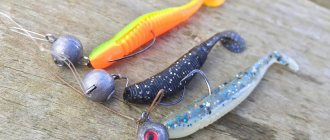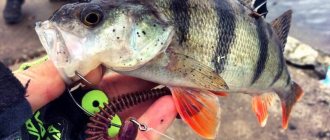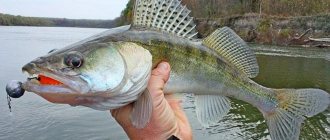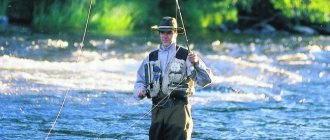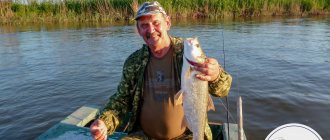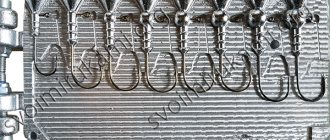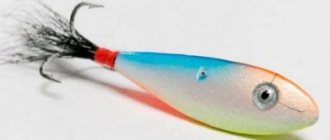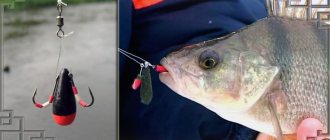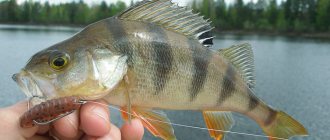What is a jig?
Fishing with jig rigs has long been firmly established among spinning anglers and has now become one of the most popular.
Jig is a type of bottom fishing for predatory fish with artificial front-loaded baits. Jig rigs also include lead rigs with sinkers - “retractable lead”, “Carolina”, “drop-shot”, etc. Animation of the bait in the water column is carried out with a spinning rod and reel.
Silicone and foam rubber imitations of predator food items, as well as fantasy baits called mandula, are used as baits.
The main types of fish that are caught with jig baits are pike perch, pike, perch, bersh, and catfish. Due to the specific nature of such fishing, certain requirements are imposed on all gear. There are some differences between shore jigging and boat jigging.
Jig reel
When fishing with jigs, anglers most often use spinning reels. The most versatile reel for jig fishing is a spinning reel with a front drag in size 2000-3000. The size of the reel must correspond to the spinning test: ultralight - 1000, small - 2000, medium - 3000.
Experienced fishermen often use multiplier reels when fishing with heavy jigs, but for beginner spinning anglers they are too difficult to master and a little expensive.
When jigging, reels are subjected to quite serious loads, the main part of which affects the transmission mechanism, so it is desirable that the gears and shafts are made of high quality materials and with maximum precision.
When fishing with a jig, high-speed retrieves are not required, so it is better for the reel to be high-torque rather than high-speed. The optimal gear ratio of the coil is from 4 to 5.
When fishing with a jig, it is desirable that the reel has a good friction brake with precise adjustment. This brake makes it much easier to catch, especially large fish.
Choosing a spinning rod for jigging from the shore
Length
When fishing with jigs on the shore, promising points are often located far from the angler. Therefore, casting distance is very important. Based on this, the spinning rod should be long enough.
On reservoirs up to 50 m wide, the length of the rod should be at least 2.2 m. On wider ones - 2.4-2.7 m. In addition to long casting, a long blank allows you to conveniently control the bait, feel the bite, and make a high-quality hook at a long distance and catch fish.
Test
The preferred rod test should be chosen based on the weight of the baits you intend to fish with. And it, in turn, depends on the depth of the reservoir, the presence and speed of the current.
The fall of the jig bait to the bottom should be clearly felt by the spinning rod. Lures weighing up to 5-6 g are classified as ultralight and require elegant rods with appropriate test. Ultralight can be recommended to anglers who already have a little understanding of jig fishing.
Such rods are usually used on small rivers and reservoirs with standing water. Basically, for jig fishing from the shore, rods with a test weight of 5-35 g are used. They allow you to comfortably fish most places accessible from the shore.
If it is possible to fish from the shore in deep holes on large rivers with strong currents, you can use forms with a test weight of up to 50-60 g. But you need to understand that the higher the test, the less informative the rod will be when fishing with light baits.
Build
Action is the ability of a rod blank to bend under load. When jigging onshore, fast and ultra-fast action rods are most often used. Such rods “work” with the first quarter or upper half of the blank. A rigid rod allows you to force fish near snags, bushes and stones. Also, a rigid blank hooks fish well at a long distance when the line is bent by the current or wind.
Recommended spinning rod models
The following spinning rod models are perfect for jigging from the shore:
- VOLZHANKA Master 2.4m 7-28g
- Silver Brook JIG PRO JPS270 2.7m 5-32g
- AIKO ESPADA ESP240ML 5-25g
- Maximus Winner 27M 2.7m 7-35g
- Zetrix Azura 802M 2.44m 7-28g
- Caiman Fervent spin 842M 2,55m 7-28g
- Black Hole Hyper-III 3.00m 10-35g
Shorter models from 2.1m are suitable for jigging from a boat.
Jig bait
For shore fishing, I use foam fish and small twisters from 2 to 5 inches. In most cases, the optimal twister length is 3 inches. I use weights weighing from 14 to 52 grams, depending on the strength of the current, depth and required casting distance. Moreover, I use weights from 14 to 32 g with 3-inch twisters, and heavier ones with 4-5-inch twisters. This is necessary so that when using larger and more floating baits, the casting range does not decrease.
Cord selection
A high-quality line is one of the components of successful fishing. It is crucial for jig fishing. To clearly feel even careful bites, bottom topography, and the behavior of the bait, braided cords are used in jigs; they have minimal stretch.
A good braided cord has a cross-section close to round, a tight weave and a smooth surface. The color of the cord itself does not play a big role. The thickness should be chosen based on the weight of the bait and the intended fish; 0.1-0.14 mm can be considered universal.
Types of jig baits
Silicone baits
The most common type of jig bait. They are divided into two main types - vibrotails and twisters. Variations of these types are sometimes found. Both varieties are good at catching predators and it is impossible to give preference to one of them. A fisherman’s arsenal should include both. The universal size for fishing is 2.5-3.5 inches.
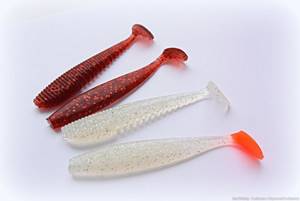
vibrotails
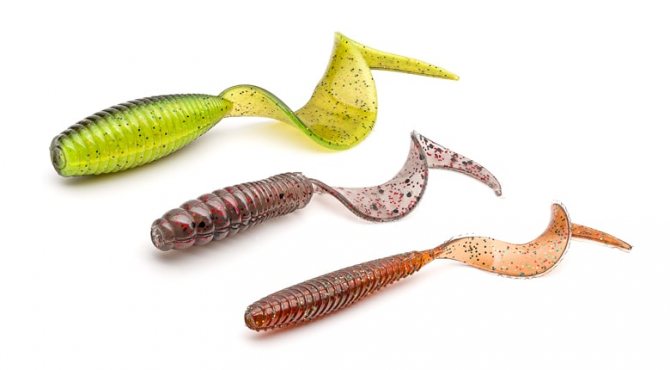
twisters
There is no one catchy color. The fisherman must have natural colors that imitate small fish and acidic colors (bright green, yellow, orange), and solid dark colors (black and brown), white or translucent.
The working color can only be determined experimentally on a pond and it can change even during the day. There is “edible” silicone - with aromatic and protein additives and inedible. For uncertain bites, edible silicone has some advantage.
There are several other types of silicone baits:
- worms
- slugs
- creatures
- octopuses

worms
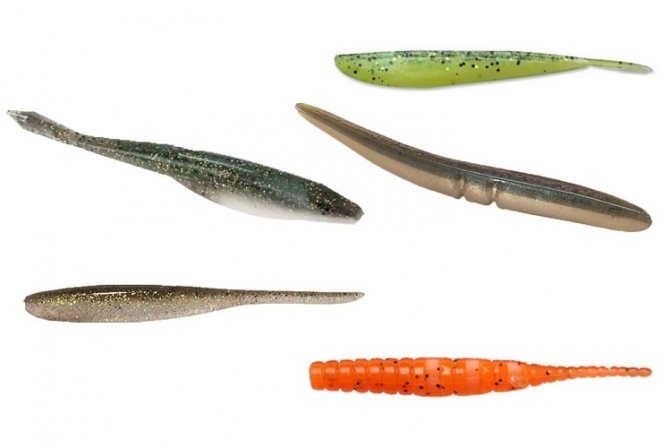
slugs
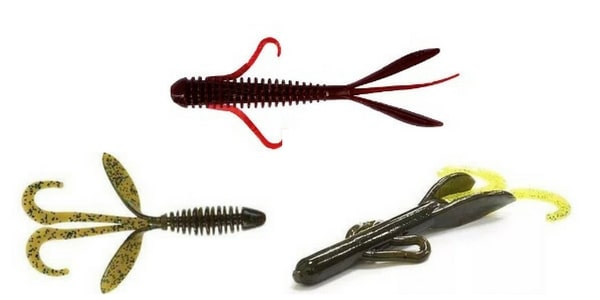
Octopus creatures
Foam rubber fish
Imitation fish made from foam rubber appeared much earlier than silicone baits, but it remains catchy to this day. In fishing slang it is simply called “foam rubber”. It is a fish cut out of foam rubber and painted in different colors.
Often looks like a cigar or an elongated teardrop. It is usually mounted on a double hook. Playing with foam rubber is no different from playing with silicone baits. Sometimes foam rubber outperforms silicone baits, especially against a passive predator.
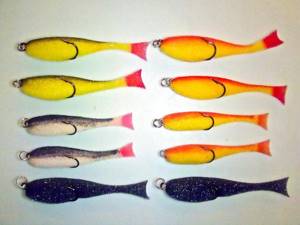
foam fish
Mandula
The bait appeared relatively recently and was originally invented for catching passive pike perch. Then it turned out that it works well on both pike and, at times, large perch. It is a hinged structure of 2-5 segments with hooks in each of them or in some of them.
The bait is made of polyurethane foam and has positive buoyancy. The mandula, held at the bottom by a weight, stands vertically and swings when manipulating the reel or rod.
As a rule, it is recruited from contrasting segments. It catches pike perch and pike perfectly, but requires a relatively clean bottom, since many bait hooks quickly get stuck in snags or stones.
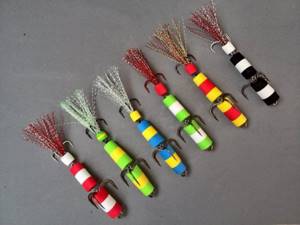
mandula
Types of leashes
When specifically fishing for pike with a jig, as well as where it is very likely to be caught, the use of leashes is mandatory. There are several main types of leashes:
- cables of different sections made of woven metal threads;
- leashes made of single metal string;
- fluorocarbon leaders.
Metal leashes often reduce the number of pike perch bites, so if you are specifically fishing for pike perch, it is better to abandon them altogether or use fluorocarbon.
In places where pike and pike perch are adjacent, it is better to use fluorocarbon leashes with a cross-section of 0.45-0.6 mm. The pike often cuts off a thinner leash. If you catch a pike with a jig, then it reacts little to a leash made of any material. The only requirement for leashes is high-quality accessories (carabiners, clasps and swivels).
Jig wiring
Posting a jig bait can be done by reeling it in with a reel or pulling it with a spinning rod, or both. A jig bait can move in the water along a variety of trajectories: evenly or stepwise, with or without touching the bottom.
You may be interested in: Fishing tackle
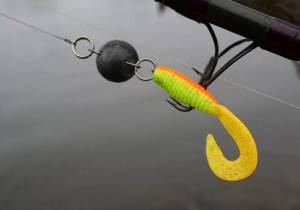
There are a large number of different jig postings. The use of a particular fishing line by a fisherman depends on the specific body of water, the intended catch, fishing conditions, and the degree of fish activity. If one jig does not work, you need to try another. If you have tried several runs and there is no result, you should change your fishing location.
In jigging, constant control of the bait is important, even if a slight sag of the line is necessary during the retrieve, the bait must be under control. A slight slack in the line is acceptable, such that the angler knows that when he lifts the rod a little, the tension will be restored.
You can fish with a jig by casting from deep to shallow water or vice versa. Jigging starts only after the bait has completely sunk to the bottom.
Stepped classic Russian wiring
The classic stepped retrieve is the main retrieve in jigging and can be used to catch a wide variety of predatory fish in a variety of reservoirs.
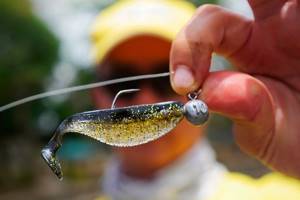
Classic Russian step wiring looks like this:
- Cast bait
- Hold the spinning rod so that its tip forms an angle of 45 degrees with the surface of the water
- Wait until the bait sinks to the bottom of the reservoir, as evidenced by the formation of sagging line and straightening of the tip of the spinning rod
- Make 1 to 3 turns with the reel handle, at this time the bait comes off the bottom and moves towards the angler, along an upward trajectory
- Make a pause, during which the bait hovers in the water column, sinking to the bottom; from the end of reeling to falling to the bottom should take from 2 to 5 seconds
- Repeat

The speed at which the bait falls to the bottom depends on the mass and dimensions of the bait, the thickness of the cord, and the strength of the current. If the falling speed of the bait is too fast, you should reduce the weight of the jig head or cheburashka weight. If the bait's falling speed is too slow, the weight should be increased.
The main baits used with classic step fishing are vibrotails and twisters; slugs, worms and crayfish are less commonly used.
Short stepped wiring
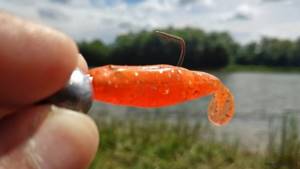
Short step wiring completely coincides with Russian classical step wiring, the only difference is a shorter step, which is done with only one revolution of the coil, but performed in a more frequent rhythm. Wiring is effective when fishing for passive fish; it works well for pike, pike-perch and perch.
American step wiring

American step fishing is similar in principle to Russian step fishing, the only difference is that the step is performed not by rotating the reel handle, but by pulling the bait with the tip of a spinning rod.
First, several pulls are made with the tip of the rod, 20-30 cm each, then the slack of the cord is pulled out with a reel. The American version of step-by-step wiring is more labor-intensive, but more effective in terms of controlling weak bites that occur during a pause.
Wiring for demolition
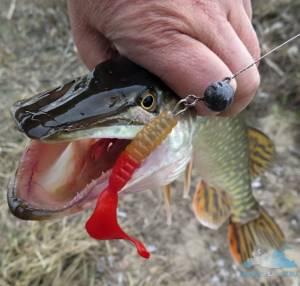
Drift fishing is effective when fishing in the current. The bait is cast across the river flow. When the bait touches the bottom, the fisherman tears it off the bottom with a sharp swing of the rod, or 1-2 turns of the reel, the current carries it down in an arc, then touches the bottom again. The fisherman is reeling in a loose line. Wiring is carried out until the cord extends along the bank downstream. When using drift fishing, it is important to select the correct weight of the load so that the current can pull the bait, but it still touches the bottom when stopping.
Aggressive tossing
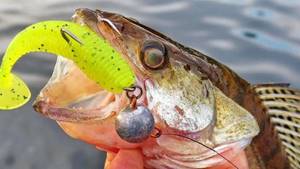
Aggressive tossing is used for catching active pike. After casting, when the bait touches the bottom, the rod is raised sharply upward, causing a sharp toss of the bait, followed by a pause, during which the bait falls to the bottom. The fisherman lowers the rod to a horizontal position and reels out the slack line.
Uniform wiring
Uniform retrieving is done by rotating the reel handle; winding is carried out at the same speed, without slowing down or accelerating, without pauses and without moving the spinning rod.
It makes sense to use uniform wiring when there is a lot of underwater vegetation, snags or debris at the bottom of the reservoir where fishing is carried out. In such places, if you fish with a classic jig step, there will be a lot of hooks and breaks of the bait, and uniform wiring allows the bait not to fall to the bottom and work in the water column, in the bottom layer.

Uniform wiring is used only with silicone baits that have their own active game. A twister is ideal for uniform wiring.
During an even retrieve, the angler can adjust the depth at which the bait is located using the position of the tip of the spinning rod and the speed of reeling in the reel. When the rod tip is raised, the bait will go closer to the surface, when lowered closer to the water, closer to the bottom. When the reel rotates quickly, the bait rises closer to the surface; when it rotates slowly, it goes deeper. You can also adjust the depth of the bait by selecting the diameter of the fishing line and the weight of the load of the bait itself. With the help of even wiring you can catch pike, perch and catfish.
Wave-shaped wiring
Wavy retrieve is based on a uniform retrieve, but with the help of a reel or movement of the rod tip, the angler forces the bait to make wave-like movements in the water.
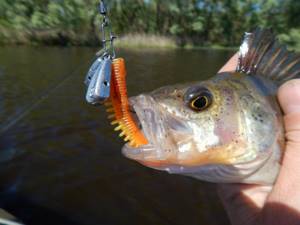
There are two ways to perform wavy wiring:
- A smooth, uniform reeling of the fishing line is carried out with a simultaneous smooth movement of the tip of the spinning rod up and down
- The line is reeled in smoothly with a reel with slowdowns, during which the bait drops lower, then reeling in with the reel is slightly accelerated, the bait rises a little higher
Pendulum wiring
Pendulum wiring is used in places with a heavily corroded bottom. With pendulum retrieving, the rod constantly moves up and down with a small amplitude while simultaneously reeling out the slack cord.
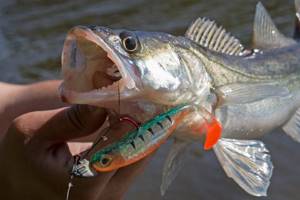
In order to perform pendulum wiring, you need to perform the following steps:
- Cast bait
- Let the load sink to the bottom
- Make a short, smooth pull with the rod up 15-20 cm, then lower the tip of the rod 5-10 cm down, while simultaneously reeling out the slack cord
- Repeat cycle
Dotted wiring
With dotted wiring, the bait drags along the bottom, moving with sharp movements of the rod tip with a small amplitude. The wiring is designed for catching pike perch.
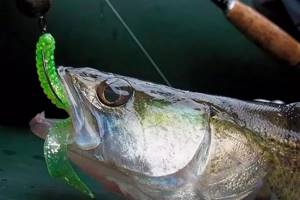
In order to perform dotted wiring, you need to perform the following steps:
- Cast bait
- Let the load sink to the bottom
- Using the tip of the rod, make neat small tosses of the bait by 5-10 cm, while simultaneously reeling in the sagging cord.
Retrieving the bait by dragging the bait along the bottom
Dragging along the bottom is used for catching passive fish. The advantage of this wiring is that the bait is located directly on the bottom and when the bait moves along the bottom, turbidity is formed, which additionally attracts fish.
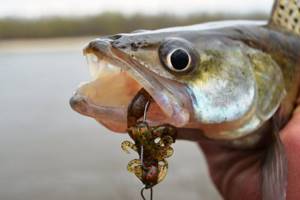
To fish with this type of fishing, you should use floating baits, which, in a calm position, take the position of a small fish standing with its tail up, feeding on the bottom. Particularly effective are silicone baits consisting of crayfish, cuttlefish, worms and nymphs. You should use a hinged mounting of the bait.
To drag the bait along the bottom, you need to place the tip of the spinning rod down, slowly rotate the reel handle, making stops while reeling in the fishing line. You need to be careful and ready to hook; bites most often happen at stops.
Types of cargo
In jig, two main types of weight are used - a jig head and a weight with two eyes (“Cheburashka”). In a jig head, the hook is tightly soldered into the weight and forms one piece with it. The hook (single, so-called offset or double) is attached to the Cheburashka with winding rings.
Recently, the most popular are collapsible, “sports” cheburashkas, a hook to which is attached to a free fastener pulled out of the weight. Lead jig rigs use sliding bullet-shaped weights or weights with a swivel in the form of drops, cigars, and cones.
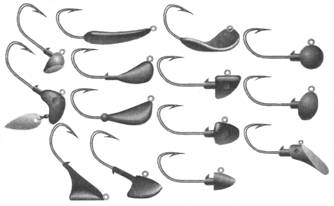
jig heads cargo Cheburashka
Installation methods
Classic jig head
The classic jig head is tied to a leash or without it, and a silicone bait is put on the hook. The hook of the head is pulled out. Due to the rigid connection, it hooks fish much better.
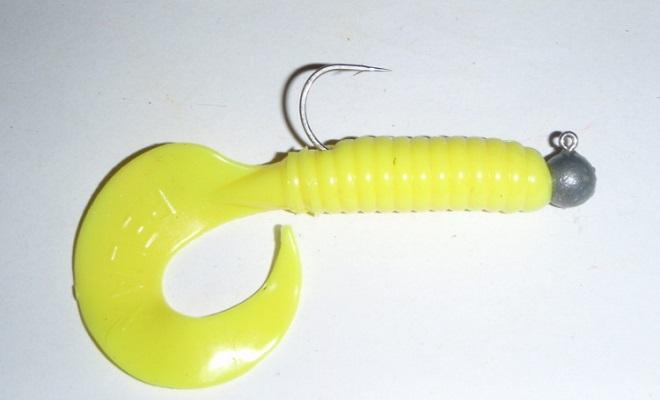
mounting on a jig head
Hinge rig with open hook
After connecting the Cheburashka with an offset hook or double, a silicone bait or foam rubber is put on them. The hooks are removed from the bait. Hinged rigs provide better animation of the bait, but are worse at detecting fish when hooking due to the movable connection of the hook with the weight.
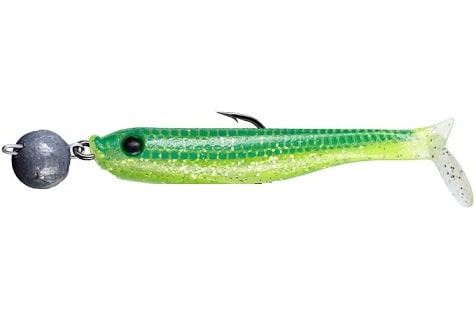
installation with Cheburashka and open hook
Hinge-free equipment
In this case, the tip of the offset hook is hidden in the body of the silicone bait or in a groove on its back so that it does not protrude beyond the dimensions of the bait. This installation cuts through the fish even worse when hooking, but allows you to fish in very “strong” places with many hooks.
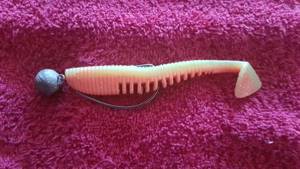
installation with a Cheburashka and a hidden “non-snacking” hook
Lead rigs
Lead rigs are installations where the hook with bait is not directly connected to the load and is in “free flight”. Such rigs are used in specific conditions - in “strong places”, when catching passive fish, when you need to deliver light bait over a long distance.
In a “branch” leash, the main cord is tied to a three-sided swivel, a sinker on a 20-40 cm leash and a leash 1-1.5 m long with a hook and bait at the end are tied to the other rings.
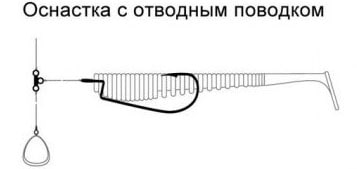
diverter leash installation diagram
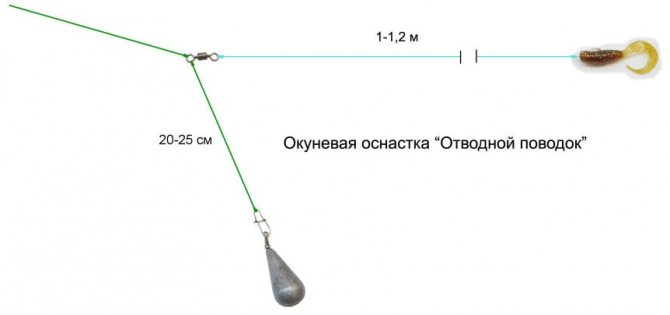
diverter leash
In the Carolina rig, the main cord is threaded into a sliding sinker in the form of a bullet or olive, then a 0.5-1.5 m long leash with bait is tied to it through a swivel.
installation diagram of Carolina equipment classic Carolina equipment
In a drop shot, the sinker is tied to the end of the leash, and at a distance of 0.4-1 m from the load, a hook with bait is tied directly to the fishing line.
drop-shot equipment installation diagram

drop shot
Types of postings
Stepped
Classic type of wiring. After the bait falls to the bottom, which is felt by the sagging of the cord, 1-3 quick turns of the reel are made. At this time, the bait comes off the bottom and moves towards the angler along an upward trajectory.
After reeling is completed, the bait falls to the bottom. The speed of the fall depends on the mass, river flow, thickness of the cord and dimensions of the bait. It is believed that with a normal step, 2-5 seconds pass from the end of the winding to the fall. After the fall, reeling follows again, and so on until the bait approaches the shore.
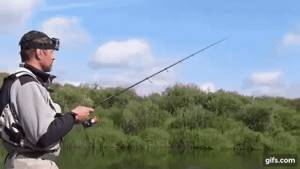
Wiring for demolition
If there is a current, after casting across the river you will feel the bottom touching. 1-2 turns of the reel lift the bait from the bottom and the current carries it down in an arc relative to the angler, then it touches the bottom again.
This wiring is carried out until the cord extends from the angler downstream along the shore. When retrieving this way, it is very important to select the correct weight of the load so that the current during reeling can pull the bait down, but at the same time it touches the bottom when stopping.
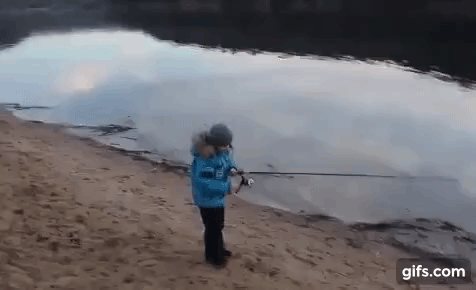
Classic jigging process
First you need to cast. The bait should sink smoothly and freely to the very bottom of the reservoir. This will be visible from the sagging line. The spinning rod should be held at an angle of 45 degrees relative to the water. You need to make about 4 turns of the reel handle and wait until the bait falls to the bottom again. After this, you need to repeat the winding again.
An angle of 45 degrees is necessary for effective hooking. Experts recommend not to exceed a right angle, since not every top of the spinning rod is able to withstand the loads during the process of hooking “over the head” . The bait is detonated using a spinning rod with a change in its position. The top of the rod is directed after casting to the place where the bait splashes down in a parallel position relative to the surface of the reservoir.
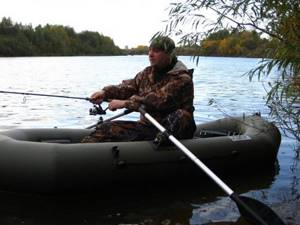
The fisherman takes out the slack in the fishing line, and the spinning rod is moved from a parallel position to a perpendicular one. It is necessary to wait for the bait to fall to the bottom (during the fall, the rod must be moved to 45-60 degrees, while picking up any slack in the fishing line) and repeat these steps again.
This fishing technique has a lot of advantages, which include quick and sharp detonation of the bait from the bottom. Thanks to its high acceleration, the bait can create vibrations in the water, which in turn will attract fish even at a great distance. However, using this method, it is quite difficult to control the bait when retrieving and often contact with it is lost.
The bite is detected by changes in the tension of the braid and the tip of the rod. The hook must be performed in a timely manner, immediately after the blow or the first poke. Almost 60% of bites occur when the bait is lowered to the bottom, so you need to carefully choose a balanced rig that will provide maximum free fall time on a short step. It is also necessary in this case not to cause harm to the gear itself.
It is also necessary to mention that when fishing with a jig downstream, you should use a smaller weight of the sinker than when fishing against the flow of water.
Search fishing
Exploratory fishing involves quickly fishing a large area of a reservoir, the purpose of which is to identify the largest concentration of fish. For the most part, search fishing is used on an unfamiliar body of water and is characterized by such an expression as “take more and throw further.” That is, the fisherman takes a weighted jig head and casts it as far as possible. Next, the classic step is carried out at an accelerated pace.
After discovering a promising place, the heavy jig head is replaced with a light one, with the help of which a soft presentation of the bait is achieved. Further, the pace of the retrieve decreases, and the bait itself, after detonation, should reach the bottom in about 10 seconds.
